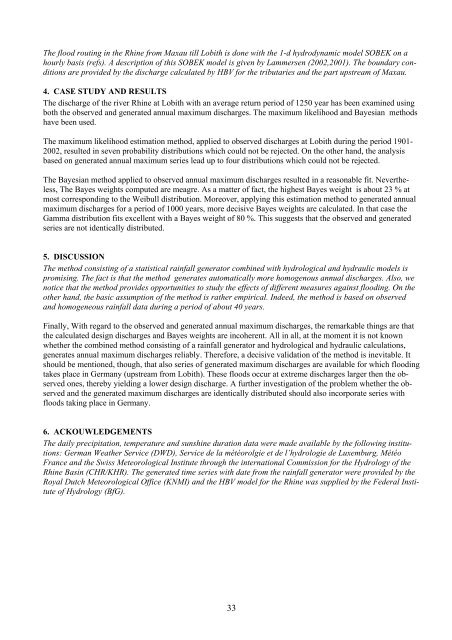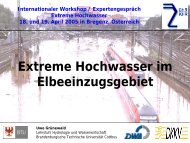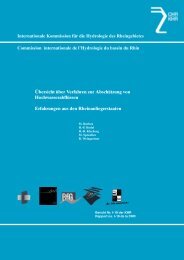ABSTRACTS 'Extreme Discharges' - CHR-KHR
ABSTRACTS 'Extreme Discharges' - CHR-KHR
ABSTRACTS 'Extreme Discharges' - CHR-KHR
Create successful ePaper yourself
Turn your PDF publications into a flip-book with our unique Google optimized e-Paper software.
The flood routing in the Rhine from Maxau till Lobith is done with the 1-d hydrodynamic model SOBEK on a<br />
hourly basis (refs). A description of this SOBEK model is given by Lammersen (2002,2001). The boundary conditions<br />
are provided by the discharge calculated by HBV for the tributaries and the part upstream of Maxau.<br />
4. CASE STUDY AND RESULTS<br />
The discharge of the river Rhine at Lobith with an average return period of 1250 year has been examined using<br />
both the observed and generated annual maximum discharges. The maximum likelihood and Bayesian methods<br />
have been used.<br />
The maximum likelihood estimation method, applied to observed discharges at Lobith during the period 1901-<br />
2002, resulted in seven probability distributions which could not be rejected. On the other hand, the analysis<br />
based on generated annual maximum series lead up to four distributions which could not be rejected.<br />
The Bayesian method applied to observed annual maximum discharges resulted in a reasonable fit. Nevertheless,<br />
The Bayes weights computed are meagre. As a matter of fact, the highest Bayes weight is about 23 % at<br />
most corresponding to the Weibull distribution. Moreover, applying this estimation method to generated annual<br />
maximum discharges for a period of 1000 years, more decisive Bayes weights are calculated. In that case the<br />
Gamma distribution fits excellent with a Bayes weight of 80 %. This suggests that the observed and generated<br />
series are not identically distributed.<br />
5. DISCUSSION<br />
The method consisting of a statistical rainfall generator combined with hydrological and hydraulic models is<br />
promising. The fact is that the method generates automatically more homogenous annual discharges. Also, we<br />
notice that the method provides opportunities to study the effects of different measures against flooding. On the<br />
other hand, the basic assumption of the method is rather empirical. Indeed, the method is based on observed<br />
and homogeneous rainfall data during a period of about 40 years.<br />
Finally, With regard to the observed and generated annual maximum discharges, the remarkable things are that<br />
the calculated design discharges and Bayes weights are incoherent. All in all, at the moment it is not known<br />
whether the combined method consisting of a rainfall generator and hydrological and hydraulic calculations,<br />
generates annual maximum discharges reliably. Therefore, a decisive validation of the method is inevitable. It<br />
should be mentioned, though, that also series of generated maximum discharges are available for which flooding<br />
takes place in Germany (upstream from Lobith). These floods occur at extreme discharges larger then the observed<br />
ones, thereby yielding a lower design discharge. A further investigation of the problem whether the observed<br />
and the generated maximum discharges are identically distributed should also incorporate series with<br />
floods taking place in Germany.<br />
6. ACKOUWLEDGEMENTS<br />
The daily precipitation, temperature and sunshine duration data were made available by the following institutions:<br />
German Weather Service (DWD), Service de la météorolgie et de l’hydrologie de Luxemburg, Météo<br />
France and the Swiss Meteorological Institute through the international Commission for the Hydrology of the<br />
Rhine Basin (<strong>CHR</strong>/<strong>KHR</strong>). The generated time series with date from the rainfall generator were provided by the<br />
Royal Dutch Meteorological Office (KNMI) and the HBV model for the Rhine was supplied by the Federal Institute<br />
of Hydrology (BfG).<br />
33





